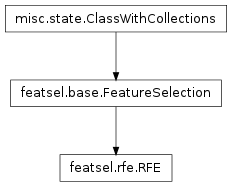This content refers to the previous stable release of PyMVPA.
Please visit
www.pymvpa.org for the most
recent version of PyMVPA and its documentation.
featsel.rfe
Module: featsel.rfe
Inheritance diagram for mvpa.featsel.rfe:

Recursive feature elimination.
-
class mvpa.featsel.rfe.RFE(sensitivity_analyzer, transfer_error, feature_selector=FractionTailSelector() fraction=0.050000, bestdetector=<mvpa.featsel.helpers.BestDetector object at 0x8d7c910>, stopping_criterion=<mvpa.featsel.helpers.NBackHistoryStopCrit object at 0x8d7cf50>, train_clf=None, update_sensitivity=True, **kargs)
Bases: mvpa.featsel.base.FeatureSelection
Recursive feature elimination.
A FeaturewiseDatasetMeasure is used to compute sensitivity maps given a
certain dataset. These sensitivity maps are in turn used to discard
unimportant features. For each feature selection the transfer error on some
testdatset is computed. This procedure is repeated until a given
StoppingCriterion is reached.
- Such strategy after
- Guyon, I., Weston, J., Barnhill, S., & Vapnik, V. (2002). Gene
selection for cancer classification using support vector
machines. Mach. Learn., 46(1-3), 389–422.
- was applied to SVM-based analysis of fMRI data in
- Hanson, S. J. & Halchenko, Y. O. (2008). Brain reading using
full brain support vector machines for object recognition:
there is no “face identification area”. Neural Computation, 20,
486–503.
Note
Available state variables:
- errors+: State variable
- history+: State variable
- nfeatures+: State variable
- selected_ids: State variable
- sensitivities: State variable
(States enabled by default are listed with +)
See also
Please refer to the documentation of the base class for more information:
FeatureSelection
Initialize recursive feature elimination
| Parameters: |
- sensitivity_analyzer (FeaturewiseDatasetMeasure object) –
- transfer_error (TransferError object) – used to compute the transfer error of a classifier based on a
certain feature set on the test dataset.
NOTE: If sensitivity analyzer is based on the same
classifier as transfer_error is using, make sure you
initialize transfer_error with train=False, otherwise
it would train classifier twice without any necessity.
- feature_selector (Functor) – Given a sensitivity map it has to return the ids of those
features that should be kept.
- bestdetector (Functor) – Given a list of error values it has to return a boolean that
signals whether the latest error value is the total minimum.
- stopping_criterion (Functor) – Given a list of error values it has to return whether the
criterion is fulfilled.
- train_clf (bool) – Flag whether the classifier in transfer_error should be
trained before computing the error. In general this is
required, but if the sensitivity_analyzer and
transfer_error share and make use of the same classifier it
can be switched off to save CPU cycles. Default None checks
if sensitivity_analyzer is based on a classifier and doesn’t train
if so.
- update_sensitivity (bool) – If False the sensitivity map is only computed once and reused
for each iteration. Otherwise the senstitivities are
recomputed at each selection step.
- enable_states (None or list of basestring) – Names of the state variables which should be enabled additionally
to default ones
- disable_states (None or list of basestring) – Names of the state variables which should be disabled
|
|---|

